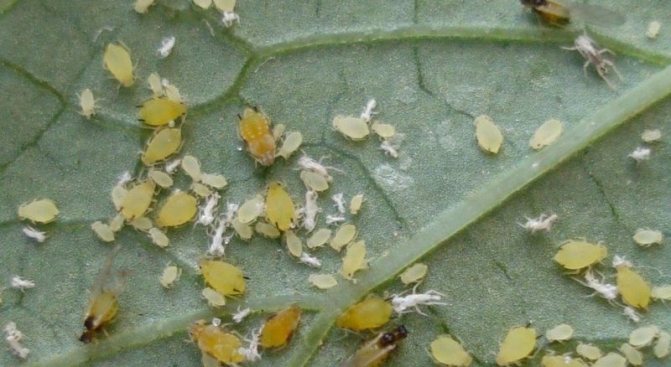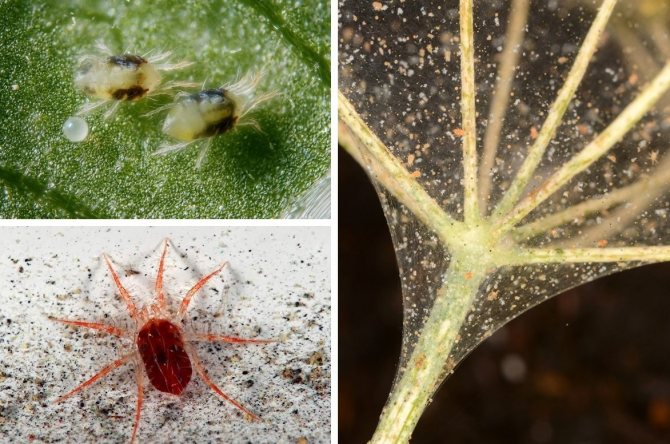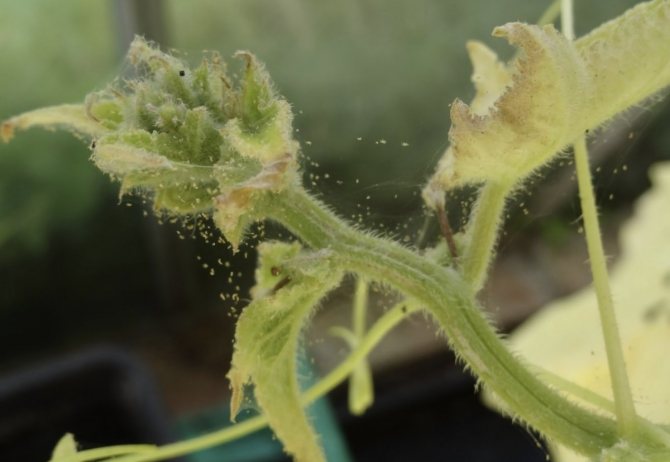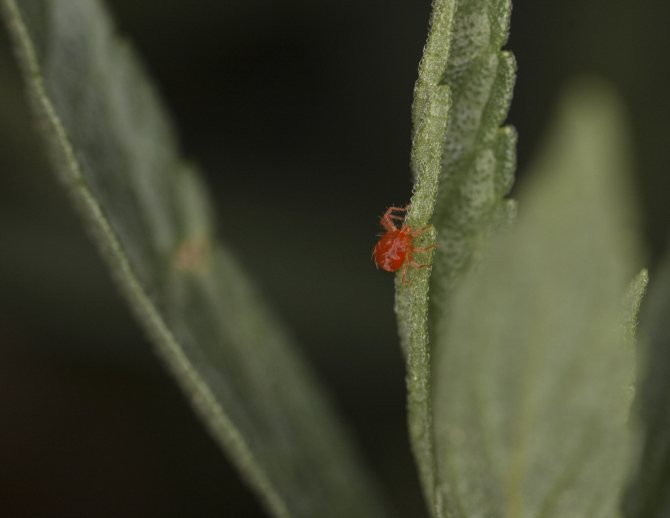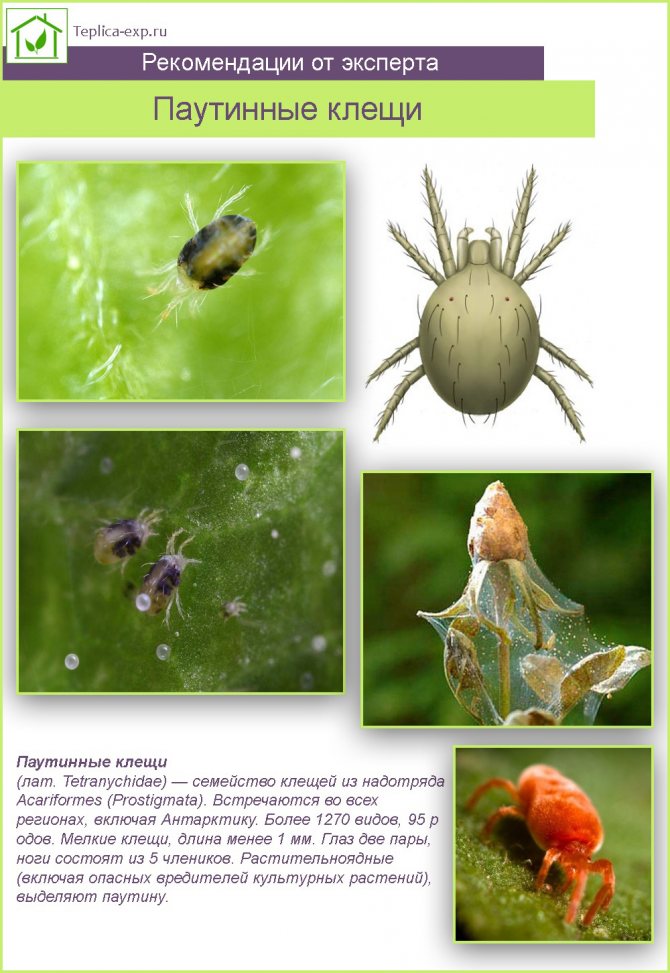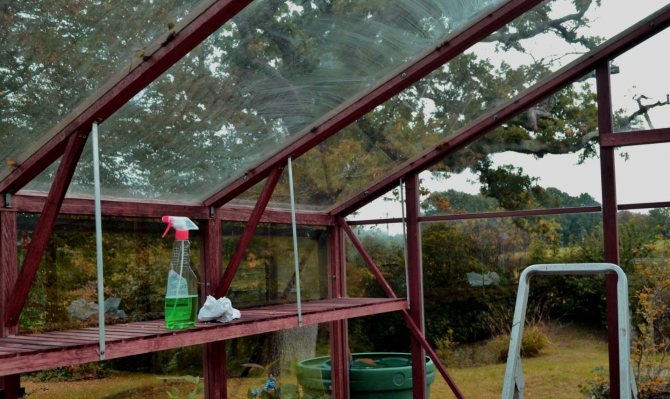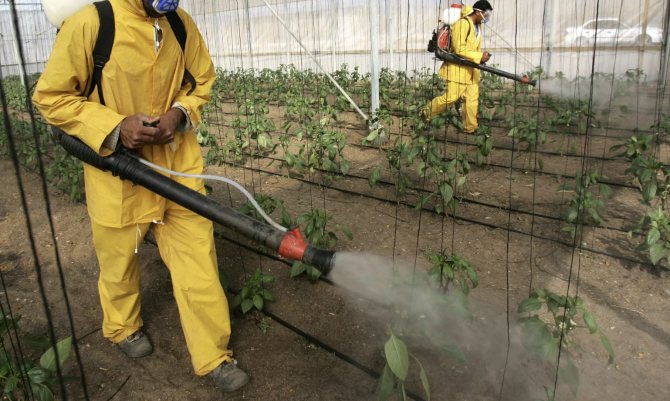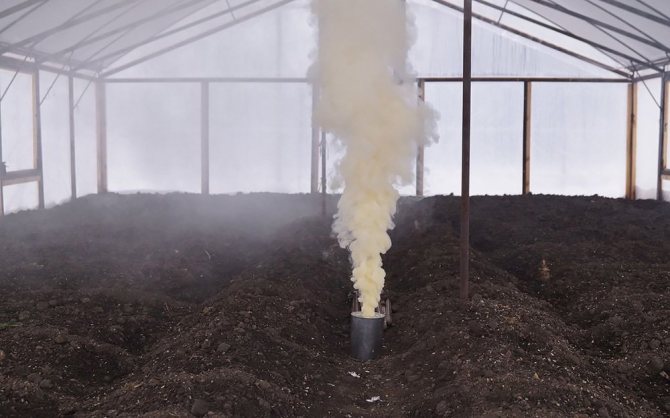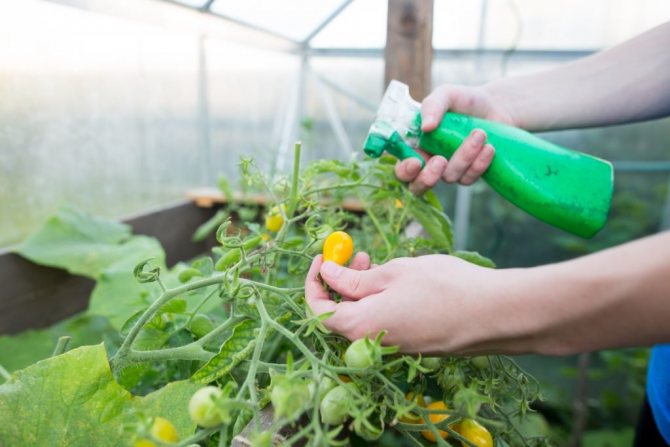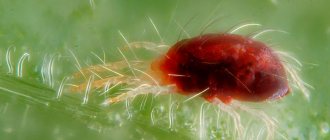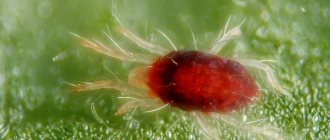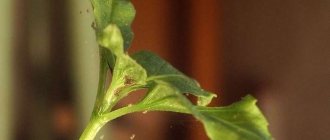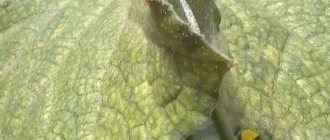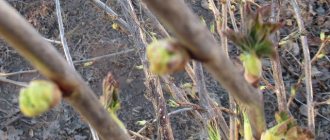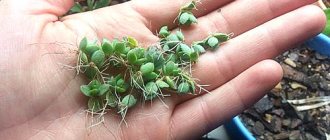Spider mite harm to plants
A small pest, the length of which rarely exceeds 0.1–0.2 mm, is almost impossible for human eyes to see, but the damage caused to it is immediately visible. The insect settles on the reverse side of the leaf blade, damages it with its proboscis, drawing out juices. In this case, chloroplasts are destroyed and the process of photosynthesis in damaged cells stops. The leaves are covered with whitish-yellow spots, then gradually dry out completely.
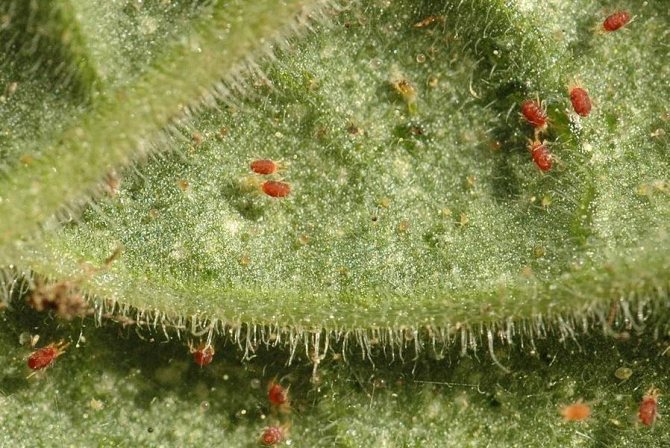
The spider mite is very small, it is difficult to see it without magnification
The plant itself, on which the spider mite has settled (and this creature multiplies extremely quickly), weakens, resists diseases and other parasites worse, stops developing and dies... Its growing season is greatly reduced, which inevitably leads to significant crop losses.
Insect characteristics
Spider mites are harmful insects that inhabit indoor plants, horticultural crops, and especially greenhouse ones - because of the favorable temperature in greenhouses for them. Fighting ticks is difficult as they are very small. They cannot be noticed until the leaves are covered with cobwebs and the plants lose their usual appearance: they become lethargic, and then dry out altogether.
The web is so strong that it is difficult to break when spraying from a spray bottle. In her cocoons, the female lays up to 400 eggs daily with a life expectancy of 40 to 50 days. From this it can be seen with what avalanche speed the increase in the number of insects occurs. In winter, the development process stops in greenhouses, and resumes with the beginning of the season.
The length of the female is from 0.4 to 0.6 mm, the size of the male is even smaller. They are pale green or amber yellow in color. Young offspring of ticks are six-legged, after several molts they become eight-legged. A favorable environment for the growth of an individual is 25-30 degrees, and its development ends in 7-8 days. At a lower temperature, this process slows down and reaches a month.
The tick belongs to the class of arachnids. Usually it is located on the back of the leaf, feeding on its juice and eating out many small holes. Leaves become dry and brittle from dehydration. Even with a slight damage, the development of the plant is suspended, and if measures are not taken to destroy the parasites, the crops lose their ability to recover, the process of photosynthesis is reduced. Diseased leaves are covered with thin cobwebs, turn yellow and fall off.
Particular harm caused by mites lies in their ability to cause significant damage to plants in a short period of time. Hordes of microscopic parasites attack plantations, which become sick and then die. This is how they differ from other plant pests. Therefore, you have to destroy them using various means.
Greenhouse treatment for spider mites in spring
Before starting a new garden season and planting plants in the greenhouse, it is necessary to properly prepare it in order to minimize the risk of spider mite damage to the plantings:
- All structures must first be thoroughly washed with a brush with warm water and any detergent, paying particular attention to joints, corners and other secluded places. Rinse with water from a hose.
- All elements of the structure are treated with a strong dark red solution of potassium permanganate, not forgetting about the inventory and various devices (stakes, ropes, etc.).
- If possible, replace the top layer (15–20 cm) of the earth or spill the soil with boiling water. To enhance the effect, cover with plastic wrap for 2-3 days. The procedure is repeated three times. You can use a household portable steam generator.
- Disinfecting the greenhouse:
- chemicals;
- smoke bomb;
- folk methods.
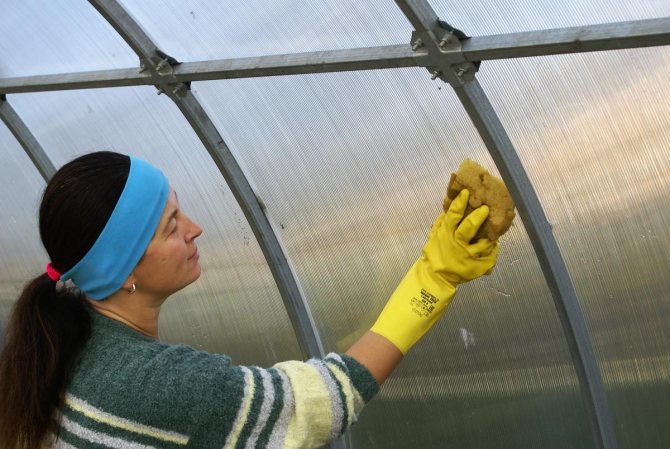

In the spring, the greenhouse must first be thoroughly washed
Chemicals
The greenhouse, both inside and outside, as well as the greenhouse soil, is carefully sprayed with one of the following formulations:
- colloidal sulfur (80 g per 10 liters of water);
- copper sulfate (5%);
- Bordeaux mixture (3%);
- bleach (0.4–0.6 kg of lime is poured with a bucket of water, insisted for 3-4 hours);
- specialized acaricidal agents (Kleschevit, Kabofos, Aktellik, BI-58, etc.), working solutions are prepared according to the attached instructions.
Smoke bomb
Treatment of greenhouses and greenhouses with sulfur smoke bombs is effective. The gaseous sulfur dioxide released during this penetrates into the narrowest and most secluded places, into any holes and crevices, killing arthropods and their larvae even in the ground.
The technology is as follows:
- Since sulfur compounds corrode metals, all metal elements must first be protected by coating them with any thick grease (grease, etc.).
- The room is sealed as much as possible, carefully sealing all cracks and holes with sealant or tape.
- The required number of checkers is placed on non-combustible bases (sheets of metal, bricks, etc.).
- The wicks are lit, starting from the farthest edge and approaching the entrance.
- They go out, closing the doors tightly.
- The greenhouse is left closed for 2-3 days, then torn off and thoroughly ventilated for at least a day.
All work must be carried out with care and exactly following the instructions, as well as using personal protective equipment (gas mask, protective gloves, etc.).
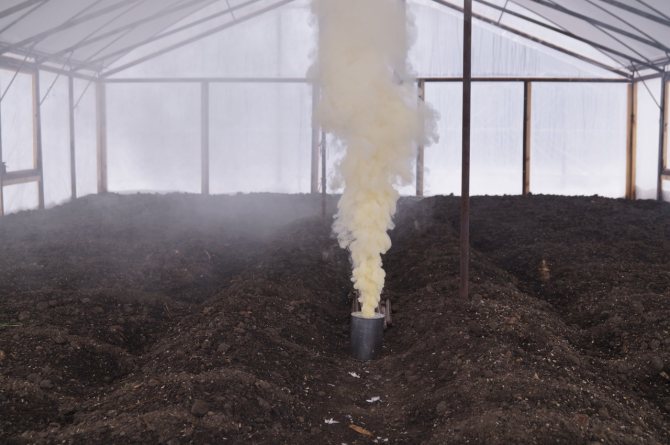

Fumigation of the greenhouse with a smoke bomb gives a good effect.
To increase efficiency, it is recommended to lightly dampen the walls and ceiling before starting treatment. Reacting with water, sulfur dioxide is converted into weakly concentrated sulfuric acid, which has disinfecting properties.
Folk remedies
Some gardeners are afraid to use chemical products for processing the greenhouse, preferring folk methods that have been proven by time and generations:
- Infusion of onion husks. Half a bucket of onion peel is poured into 10 liters of boiling water and insisted for 2-3 days under a closed lid. After filtration, the entire structure is sprayed.
- Tansy decoction. Dried tansy (200-300 g) is boiled in a bucket of water for about 15 minutes, cooled, filtered and used for processing.
- Infusion of citrus peels (orange, lime, tangerine, lemon). Crushed peel (1 kg) is infused for 5 days in 3 liters of water. The working solution is prepared from ½ glass of infusion and a bucket of water.
- Garlic infusion. Clean two large heads from scales, chop finely and pour a liter of warm water. After insisting for 5 days, strain and dilute with water in half.
Movement and stay of arachnids
In winter, the female tick with the eggs laid by it lies in the ground and under the bark of trees. With the arrival of spring, they move to unharvested nearby weeds, and later to plants.
The spider mite is able to move actively. Even with a usually sedentary lifestyle, as he eats up food supplies, he goes to look for a new habitat.Pests move with the help of their webs, which are carried by the wind, or slowly crawl over short distances.
Indoor flowers and greenhouse plants can become infected with pests from new seedlings, soil. Insects even get into the apartment from things, shoes, and independently penetrate through an open window.
Parasites are introduced into the greenhouse, staying on the gardener's clothes, the hair of a cat that accidentally ran into the building, with seedlings. It is almost impossible to avoid insects entering the greenhouse. It is difficult to deal with them, but if measures are taken in a timely manner, you can grow plantings without fear of an invasion of pests.
At the first stage of being in the greenhouse, it is very difficult to find them. If you look closely, you can see whitish dots on the back of plant leaves, usually along the main vein. Over time, these marks will turn yellow and discolored. But after only 8-10 days, you can see parasites scurrying along the leaves of cucumbers or tomatoes.
After a while, the plants will be covered with areas braided by a thin web - it is in these places that colonies are arranged and pests actively reproduce, and then spread to other plants. Interspersed with white dots on the leaves is a sign of the existence of parasites in the greenhouse.
Sometimes the cobweb may be absent altogether, if there are not too many insects yet. Plants that are located at the edges of the passage are the first to suffer, they are more susceptible to attack by ticks from the street.
You need to know that a spider-like creature is not dangerous to humans, does not bite and is not a carrier of any diseases. Dangerous only for crops.
How to prevent spider mites from growing in the greenhouse
It is quite difficult to fight a spider mite, however, you can reduce the likelihood of its appearance in the greenhouse by taking several preventive measures:
- Timely, twice a year (in autumn and spring), put things in order, wash and treat the entire greenhouse structure with appropriate preparations.
- It is imperative to carry out deep soil reclamation, completely replacing or disinfecting it.
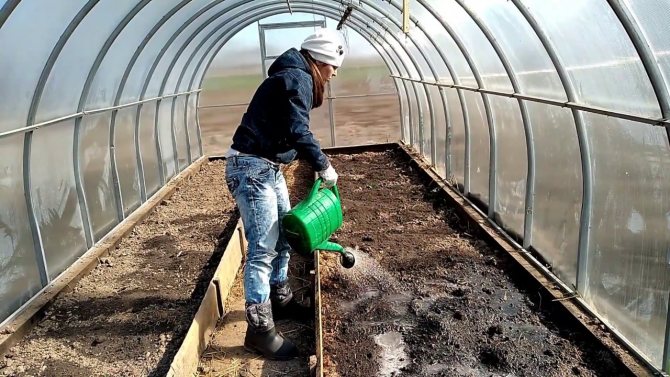

The soil in the greenhouse also needs to be treated and watered with disinfectants.
- Under no circumstances should you plant the plants too thickly. Condensation should not be allowed.
- Constantly carefully weed out weeds, not only inside the building, but also outside it.
- For planting, choose varieties of eggplant, cucumbers, tomatoes and peppers that are most resistant to damage by harmful arthropods.
- Indoors, maintain high air humidity (70–80%), which is uncomfortable for ticks.
- Spray the aerial part with cool water twice a day (mites do not like this very much).
- Regularly (every 2-3 days) carefully inspect the plantings, immediately pick off the affected leaves.
- Observe the crop rotation, changing crops in places.
- Planting repellent arachnid plants (calendula, marigolds, etc.).
Currently, there are still no cultivated plants that are not affected by spider mites at all. But some varieties of cucumbers (Augustine, Murashka, Benefis, etc.), eggplant (Caliph, Samurai Sword, etc.), peppers (Hercules, Prince, etc.), tomatoes (Orange giant, Apollo, Estonian, etc.) like this arthropod pest is much less.
For the past few years, I have tried to keep spider mites out of my greenhouse. To do this, in the morning and in the evening, I pour cold water on all the cucumber lashes from a hose through a mesh spray. Since this pest multiplies especially rapidly in hot and dry weather, I reduce the temperature inside the room as much as possible (by airing, spraying with water, shading, etc.). All these preventive measures can significantly extend the growing season and reduce crop losses.
Description of the pest
The fight against a tick will be successful if you know that this particular pest has settled on your cucumbers:
- The insect belongs to the arachnids, has 4 pairs of legs.
- The whiskers and wings are missing.
- The mite can be red, yellow-green, or orange.
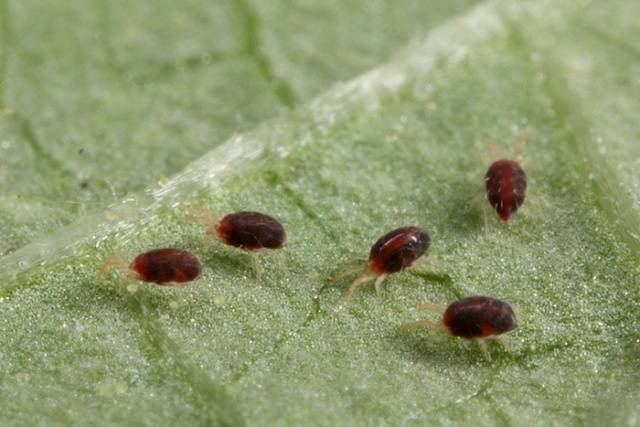

- It is difficult to see the pest due to its negligible size: an adult tick is no more than 1 mm long. Although it is rare for gardeners, there were two times more specimens.
- The habitat is the lower part of the leaf on which a cobweb is woven. Experienced gardeners notice the pest in the greenhouse by the light small dots on the upper surface of the cucumber leaves.


The tick multiplies instantly. Judge for yourself: one female is capable of laying 400 eggs per day, and she lives for at least 30-50 days. Mites appear from the eggs, which after a while lay eggs by themselves, hiding them in the cobweb.
The development cycle continues continuously. Even in autumn, females manage to lay eggs. The pests that appeared in the greenhouse in the last warm days winter well, and everything starts anew.
What methods of struggle to use if the infection has already occurred
It is quite difficult to fight a spider mite that has settled in a greenhouse; traditional insecticides against this pest are ineffective. Only specialized acaricidal preparations that kill any species of arthropods are guaranteed to help (recall that the tick is not an insect). When processing plantings, it is necessary to work in rubber protective gloves and a respirator, avoiding contact with the active substance on open areas of the body and in the eyes.
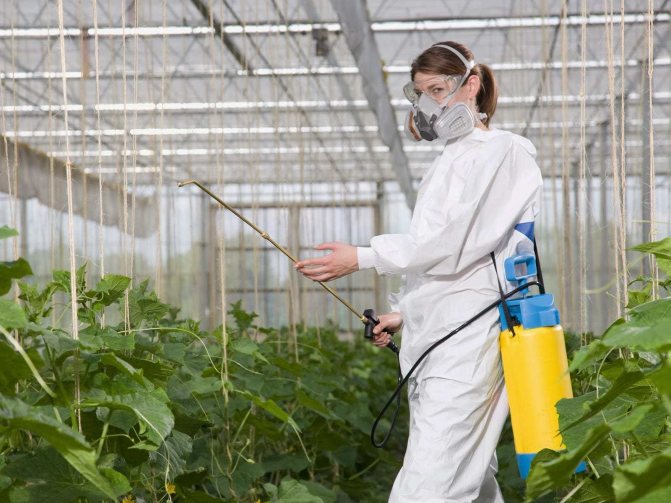

Spraying plants in a greenhouse should be carried out using personal protective equipment
There are universal remedies - insectoacaracides, effective against ticks and a whole range of harmful insects.
Chemical
In the struggle to preserve the harvest, chemical products are the most effective... Since almost all of them are toxic, then they should be used strictly according to the instructions, which must first be studied in the most careful way. Let's consider some of them in the table.
Table: Chemicals against spider mites in the greenhouse
| A drug | How to breed | Duration of protection | Consumption rate (per 10 m2) | Multiplicity of processing | Possibility of harvesting after processing |
| Actellic | 2 ml (ampoule) for 2 liters of water | 10-21 days | 1 L | 2–3 | 20 days |
| Karbofos | 60 g per 10 l of water | 10-14 days | 1 L | No more than two times per season | 20-30 days |
| Anti-mite | 1 ml for 1 liter of water | 7-15 days | 1-3 l | 1 | 5 days |
| Fufanon | 10 ml for 10 l of water | 14-21 days | 1-2 l | 1–3 | 60 days |
| Sunmight | 1 g for 1 liter of water | 5-6 weeks | 1 L | 1 | 21 day |
With a strong infection of vegetable plantings with a spider mite, it is recommended that after the first treatment, re-spraying is carried out after 5-7 days, since not all preparations have a detrimental effect on the eggs of the pest. To consolidate the effect, you can treat the plants a third time in another week.
Since the spider mite is extremely tenacious, moreover, it easily gets used to chemicals and develops resistance, experienced vegetable growers advise not to use the same drug more than twice.
Biological
Bioacaricides, which contain living colonies of fungi that have a detrimental effect on arachnids, are considered much less toxic. However, they act exclusively on adult ticks, without affecting their eggs and larvae in any way. You will have to use such funds several times per season. With a strong infection of greenhouse vegetable crops, these drugs may be ineffective.
Among the acaricides of biological origin, the most popular are:
- Fitoverm. The working solution is prepared from 1 liter of water and 8–10 ml of the preparation (consumption per 10 m2 - 1 liter). After 2 days after processing, the harvested fruits can be eaten. Spray several times at intervals of 7-10 days.
- Bitoxibacillin. Dilute 100 ml of the product in a bucket of water. Plants are sprayed at a rate of 1 to 3 liters per m2. After 15 days, the procedure is repeated.The waiting period after spraying is 7 days.
- Agravertine. The contents of one or more ampoules (depending on the degree of infection) are dissolved in a liter of water, treated with an interval of 7 days from 2 to 4 times. Harvesting is allowed after 48 hours.
The effect of biological acaricides is maximal at high ambient temperatures (+ 18… + 32 ° C). When the temperature drops to + 13 ... + 15 ° C, these funds become practically useless.
Agrotechnical techniques
It is quite possible to etch a spider mite out of the greenhouse if you follow certain rules of agricultural technology... Phased plan:
- In the fall, it is necessary to remove all plant residues from the greenhouse, replace or disinfect the soil, since it is in it that pests winter.
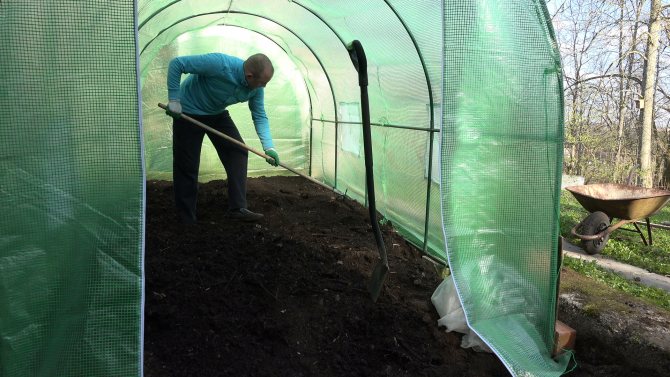

It is better to replace the soil in the greenhouse completely or, in extreme cases, dig deep
- Perform a general cleaning. Rinse and disinfect all structures.
- Fumigate with a sulphurous smoke bomb.
- Throw snow inside.
- In the spring, carry out the appropriate preparatory measures (if they were not fully done in the fall).
- After planting the plants, try to maintain the desired microclimate (temperature and humidity). Spray with water.
- Pull weeds and loosen soil regularly.
- At the first sign of infection, immediately remove and destroy all affected plant parts.
- Wipe the foliage with soapy water to remove the cobwebs. Use herbal decoctions and other folk methods.
- Use gentle biological agents first.
- In the absence of a visible effect, proceed to more potent chemistry.
An unconventional method of dealing with spider mites
An unusual and rather specific, but at the same time absolutely harmless for pets and humans, way to get rid of harmful arachnids is to use their natural enemies - entomophages. These include predatory mites: abliseius, metaseiulus, phytoseiulus, which feed on adult spider mites, immature individuals and eggs.
You can buy paper boxes with helpful helpers at any gardening store. After opening the package suspended on the affected plant, the predators crawl out on their own and begin to hunt pests.
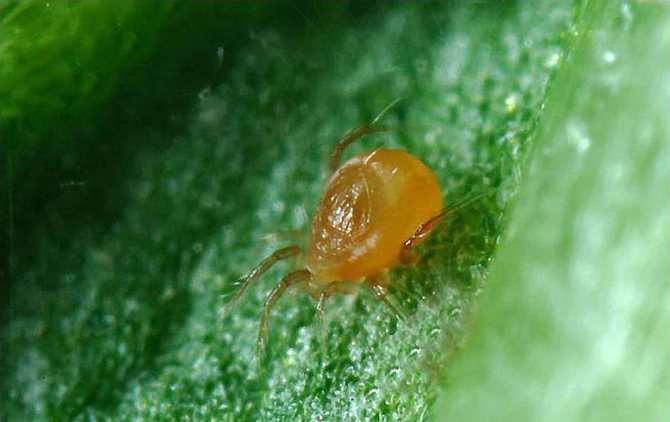

Fitoseiulus persimilis (Phytoseiulus persimilis) is a predatory mite used to protect crops from spider mites
Folk ways
If the number of pests is still small, then folk remedies can help:
- Alcohol. All the leaves are rubbed with it. Repeat after a few days.
- Laundry soap. They wipe the plants with a sponge with soapy water or simply spray them, not forgetting to water the earth.
- Dandelion infusion. 0.2–0.4 crushed rhizomes or 0.5 kg of green leaves are soaked in 10 liters of warm water for 3-4 hours. Strain and use fresh.
- Infusion of henbane. The dried plant (1 kg) is infused for 12 hours in a bucket of water.
- Tobacco broth. Dry raw materials (0.4 kg) are poured into 10 liters of water, kept for a day, then boiled for 2 hours. You can simply pollinate the plants with makhorka.
- Potato tops. A bucket of water is poured with 1.5 finely chopped tops, after 3-4 hours you can use it.
- Tomato tops. Filled with 10 liters of water, 0.4 kg of chopped tomato greens are boiled for half an hour.
- Infusion of hogweed. 1 kg of dried plant parts (stems, leaves, roots) is infused for 5-6 hours in 10 liters of water.
For better fixation of medicinal solutions on the leaves, it is recommended to add liquid soap (30–40 g per 2 l) or household soap shabby on a grater.
Spraying with folk remedies must be repeated every 4–5 days until the pests are completely exterminated.
Folk remedies
If agrotechnical methods for the destruction of insects prevent their appearance, then using folk methods can be fought when the tick has already occupied the greenhouse and poses a threat to the future harvest. If fruits have appeared on the plants or they are soon to be harvested, it is not necessary to use chemicals.It is better to use old reliable means that do not harm plants and fruits, but have a detrimental effect on parasites. You can use the following methods:
- Prepare an infusion of potato tops and pour over the beds. After 2-3 hours, the ticks will die, but the eggs will remain unharmed. Therefore, you need to additionally process 3-4 times.
- Sprinkle with the same broth with the addition of a solution of laundry soap. After this procedure, not only arachnids die, but also aphids and other pests.
- Watering with onion peel infusion will help get rid of parasites.
- Herbs are also used: common dope, alder, wormwood carpezium, garlic extract.
To scare away and also to kill insects, you can spray plants with vinegar, hydrogen peroxide or ammonia. The method of washing the leaves is used with infusion of horseradish, yarrow, garlic and the most common remedy for ticks - a solution of tar or laundry soap.
If the infection of the beds is insignificant, you can briefly cover them with polyethylene, so that moisture remains longer, which has a detrimental effect on most of the individuals. However, the treatment of a greenhouse from a spider mite with folk remedies is capable of destroying only some of its species, and with the simultaneous use of chemicals, the result will be more effective.
Useful advice from experienced gardeners
Too much depends on the type of sprayer. Aktellik is good in its own way, but it is contact, and it is not easy to ensure the processing of the entire area of the sheets both from above and below. It is urgent to water the plants to ensure active sap flow. Apply the drug BI-58 New 10-15 ml per 10 liters of water. It has pronounced systemic properties, that is, if the entire area of the sheets is not processed, then the tick biting into the sheet will still die, because the drug moves with juice.
Vadimovich
.Very praised for the last season by Vertimek. The active substance of the drug VERTIMEK, EC for the protection of flower crops in greenhouses and green cucumbers from ticks and thrips. - abamectin - belongs to the chemical group of avermectins, waste products of the soil fungus Stereptomyces avermitilis. Abamectin penetrates the treated surface within a few hours after drying the working solution inside the tissues of the plant. It practically does not remain on the leaf surface, and this feature is successfully used in integrated plant protection systems - in particular, when releasing entomophages. Since no residual amounts remain on the surface of plants, beneficial insects do not have contact with the active substance of the drug VERTIMEK, EC, while leaf-eating, mining and sucking harmful organisms absorb abamectin when feeding.
andostapenko
I don't fight a tick on them (well, except for the standard one, do not thicken, remove diseased leaves), so I noticed that there are varieties that are more or less resistant to ticks. The most persistent, according to my observations, is Anyuta F1, I wrote about him. They also get infected, but somehow it is not critical. They continue to grow and bear fruit until frost.
Sverdlovsk
There are two points. First, the more drugs you use in the greenhouse, the more pests. And it doesn't matter what classes and types of insecticides. The relationship is simple - using insecticides, you kill first of all entomophages. They are active and get everything at once. Pests get much less, therefore they recover much faster, and in the absence of predators - in greater numbers. And the second point: the infection occurs from outside the greenhouse. It is there that the foci of infection are located. And the main ones are buildings, the owners' household goods, just weeds, compost heaps and other rubbish. And the more this "good" - the higher the risk of the existence and development of foci of infection. This applies to both pests and diseases.Using only insecticides, without taking into account other factors, you can only achieve poisoning of the soil and fruits. This does NOT reduce the risk of infection. Humanity has eaten more than one dog on this. And do not think that everyone did not succeed, but I will succeed. Will not work. Poisoning yourself is easy, but a new infection cannot be avoided. The problem must be solved in a complex. And first of all, by improving the soil. Both inside the greenhouse and outside. Everything else is in the form of an ambulance.
leon747
Unfortunately, there is no panacea for this sinter eater .. It always goes in pairs with high temperatures, so this measure is very effective during the beginning of the growing season .. When watering, carefully spill paths, wooden and metal parts of the greenhouse, that is, create a humid environment ... the first signs of the appearance of this parasite, urgently spray the foliage on both sides with Fitoverm and also Biotlin (a new biological product) a couple of times with an interval of 4–5 days, destroy the heavily infected leaves. The most important thing is to be in time, otherwise the plants will die before your eyes within three to four days ... And as a deninfection after harvesting the plants in the greenhouse, you need to burn a sulfur block and treat the soil with a solution of copper sulfate.
Homochka
You need to fight spider mites by systematically spraying vegetable crops with clean water (especially in hot weather). In addition, it is necessary to constantly destroy weeds, spray the plants with an infusion of onion or garlic husks (200 g of husks per 10 liters of water), pollinate with ground sulfur (300 g of sulfur per 100 square meters. Meters), and in the fall it is imperative to dig deep into the area, removing from soil all plant residues. Of the chemicals in the fight against spider mites, you can use Fitoverm (4 ml per 5 l of water) and Karbofos (50 g per 10 l of water). Spraying with these preparations is carried out in the morning or in the evening, and during processing it is necessary to ensure that the inner side of the leaves is properly moistened.
Lyubov Zherebtsova
Drugs
If a small number of plants are infected with a tick, then it is advisable to use traditional methods of pest control. However, if a harmful insect has infected most of the crops in the greenhouse, then it is necessary to use various chemical agents, but their disadvantage is that they also negatively affect the crop itself.
You can remove the tick using the following drugs:
- Fitoverma - they can be sprayed with both seedlings and indoor plants;
- Benzyl benzoate - effectively fights all types of mites;
- Bi-58 - should be used if it was not possible to achieve a positive effect by other means;
- Aktofita - will show good results if spraying is carried out in clear weather.
The plants should be watered abundantly before applying the chemicals. This should be done so that crops are less stressed and not burned. In order for the result of processing plants to be as good as possible, experienced gardeners recommend adding potassium soap (50 g) to the solution.
Prevention measures
The mite is incredibly resistant to many difficult conditions. However, if prevention is carried out, it will be possible to prevent infection. Of course, it is easier to protect indoor flowers from them, but it is much more difficult to save greenhouse flowers.
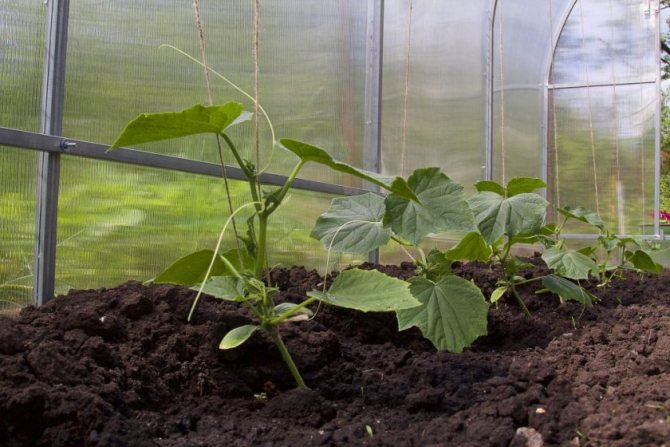

There are such preventive measures:
- Try to plant shrubs as distant as possible.
- Maintaining air humidity inside the greenhouse at a level of 80–90%, as well as temperatures up to 25 ° C, will create unsuitable conditions for their life.
- Also, in order to protect the crop, irrigation of trunks with acaricides is suitable.
- Planting a number of marigolds will help to reduce migration, reduce the settlement of the pest.
- Processing, weeding, digging, cleaning up spoiled fruits, crops, it is also mandatory to inspect for the presence of white spots.
- It is imperative to restore cleanliness and order inside the covered area in the fall, before wintering. Sometimes you need to replace the soil.
- Arachnids do not feel well under ultraviolet radiation, so 2 times a week it is worth irradiating the territory with ultraviolet light.
- New indoor flowers should be quarantined for the first time. It is imperative to maintain humidity by spraying. Before planting crops, it is important to disinfect the soil mixture - pour abundantly with boiling water, hold in the oven at 180 ° C, boil in a water bath.
The spider mite is a rather significant danger in the process of growing plants: the entire crop may be affected, therefore it is very important to resort to effective methods of prevention and control. Despite the fact that this is quite difficult, do not despair, but continue to apply an integrated approach.

